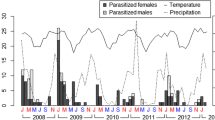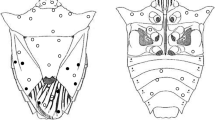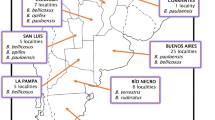Summary
We present field data on the ecology of a host-parasite system, consisting of several species of parasitoid flies (Conopidae, Diptera) and their bumblebee hosts (Bombini, Apoidea, Hymenoptera). Host animals were systematically sampled from different study sites throughout a season and checked for successful infestation in the form of puparia of these endoparasitic flies. Such dissection of the bees revealed that infestation occurs primarily during the summer months (June to September), with an observed maximum frequency of parasitization of 46.7% in workers in one of our study sites. On average, 13.2% of all workers (range 0–46.7%) and 7.1% of all males (range 0–28.6%) contained the puparium of a conopid. Two conopid generaSicus (64% of cases) andPhysocephala (36%) accounted for the infestation, with the latter being more abundant later in the year. A multivariate analysis identified host species, sex (male or worker), and study area as the most important factors accounting for the observed variance in the probability of being parasitized during the summer months. On average, males were less affected than workers. The marked seasonal appearance of conopids seems to account for differences among species, in particular for low levels of infestation among species completing their life cycles early (e.g.B. pratorum) and among the early flying, hibernated quens ofBombus andPsithyrus species. The results are discussd with respect to the impact of conopids on host ecology and evolution. Additional observations on the occurrence of further endoparasites (Sphaerularia bombi andSyntretus sp.) are reported.
Zusammenfassung
Ergebnisse aus einer Feldstudie zur Ökologie eines Wirt-Parasit Systems, bestehend aus mehreren Arten von parasitoiden Fliegen (Conopidae, Diptera) und ihren Hummel-Wirten (Bombini, Apoidea, Hymenoptera), werden dargestellt. Wirtstiere wurden systematisch in verschiedenen Untersuchungsgebieten über eine ganze Saison gesammelt und auf erfolgreiche Parasitierung, erkennbar am Puparium der endoparasitischen Fliege, geprüft. Parasitierung erfolgt vor allem in den Sommermonaten (Juli–September), wobei die beobachtete maximale Häufigkeit des Befalls 46.7% (für Arbeiterinnen) betrug. Durchschnittlich sind 13.2% aller Arbeiterinnen (Spannweite: 0–46,7%) und 7.1% aller Männchen (0–28.6%) befallen, d.h. enthielten ein Puparium wenn die Tiere nach ihrem Tod im Labor eröffnet wurden. Zwei Conopiden-Gattungen,Sicus (64% der Beobachtungen) undPhysocephala (36%) waren zu finden, wobei die letztere später im Jahr häufiger wird. Eine multivariate Analyse zeigte, dass Wirtsart, Geschlecht (Arbeiterin, Männchen) und Undersuchungsgebiet die wichtigsten Faktoren sind, welche die Wahrscheinlichkeit der Parasitierung beeinflussen. Im Durchschnitt waren Männchen weniger befallen als Arbeiterinnen. Das ausgeprägte saisonale Auftreten der Conopiden scheint in erster Linie für die Unterschiede im Befall zwischen Wirtsarten verantwortlich zu sein. So sind frühe Arten (z.B.B. pratorum) und früh fliegende Königinnen vonBombus undPsithyrus im Frühjahr kaum befallen. Die Ergebnisse werden im Zusammenhang mit dem möglichen Einfluss der Conopiden auf die Ökologie und Evolution des Wirts diskutiert. Zusätzliche Beobachtungen über das Vorkommen weiterer wichtiger Endoparasiten (Sphaerularia bombi undSyntretus sp.) werden berichtet.
Similar content being viewed by others
References
Alford D.V., 1968. — The biology and immature stages ofSyntretus splendidus (Marshall) (Hymenoptera: Braconidae, Euphorinae), a parasite of adult bumblebees.Trans. R. ent. Soc., Lond., 120, 375–393.
Alford, D.V., 1975. — Bumblebees.Davis-Poynter, London.
Askew R.R., 1961. — On the biology of inhabitants of oak galls of Cynipidae (Hymenoptera).Trans. Soc. Br. Entomol., 14, 237–268.
Askew R.R., Shaw M.Q., 1986. — Parasitoid communities: their size, structure and development. In: Waage J.K. and Greathead, D. (eds.),Insect Parasitoids. Academic Press, New York, pp. 225–264.
Brian A.D., 1952. — Division of labour and foraging inBombus agrorum Fabricius.J. Anim. Ecol., 21, 223–240.
Cumber R.A., 1949. — The biology of humble-bees with special reference to the production of the worker caste.Trans. R. Ent. Soc. Lond., 100, 1–45.
Freeland W.J., 1983. — Parasites and the coexistence of animal host species.Am. Nat., 121, 223–236.
Hassell M.P., 1986. — Parasitoids and population regulation. In: Waage, J.K. and Greathead, D. (eds.).Insect Parasitoids. Academic Press, New York, pp. 201–224.
Heinrich B., 1975. — Bee flowers: a hypothesis on flowers variety and blooming times.Evolution, 29, 325–334.
Heinrich B., 1979. — Bumblebee Economics. Harvard University Press, Cambridge, Mass.
Heinrich B., Heinrich M.J.E., 1983. — Heterothermia in foraging workers and drones of the bumblebeeBombus terricola.Physiol. Zool., 56, 563–567.
Holt R.D., 1977.— Predation, apparent competition and the structure of prey communities.Theor. Popul. Biol., 12, 197–229.
Lessells C.M., 1985. — Parasitoid foraging: should parasitism be density-dependent?J. Anim. Ecol., 54, 27–41.
Loken A., 1973. — Studies on Scandinavian bumble bees (Hymenoptera, Apidae).Norsk. Ent. Tijdskr, 20, 1–218.
MacFarlane R.P., Pengelly D.H., 1974. — Conopidae and Sarcophagidae (Diptera) as parasites of adult Bombinae (Hymenoptera) in Ontario.Proc. Entomol. Soc. Ontario, 105, 55–59.
May R.M., Anderson R.M., 1983. — Epidemology and genetics in the coevolution of parasites and hosts.Proc. R. Soc. Lond., 219, 281–303.
Myers J.H., 1981. — Interactions between western tent caterpillars and wild rose: a test of some general plant herbivore hypotheses.J. Anim. Ecol., 50, 11–25.
Pleasants J.M., 1983. — Structure of plant and pollinator communities. In: Jones, C.E. and Little R.J. (eds),Handbook of Experimental Pollination Biology. Van Nostrand Reinhold, New York, pp. 375–393.
Plowricht R.C., Laverty T.M., 1984. — The ecology and sociobiology of bumble bees.Ann. Rev. Entomol., 29, 175–199.
Postner M., 1951. — Biologisch-ökologische Untersuchungen an Hummeln und ihren Nestern.Veröff. Mus. Natur Völker u. Handelskde. Bremen (A), 2, 46–86.
Pouvreau A., 1974. — Les ennemies des bourdons. II. Organismes affectant les adultes.Apidologie, 5, 39–62.
Price P.W., 1980. — Evolutionary Biology of Parasites.Princeton University Press, Princeton, N.J..
SAS Institute Inc, 1985. — SAS User's Guide: Statistic, Version 5 Edition. SAS Institute Inc., Cary N.C.
Schmid-Hempel P., Schmid-Hempel R., 1988. — Parasitic flies (Conopidae, Diptera) may be important stress factors for the ergonomics of their bumblebess hosts.Ecol. Entomol., 13, 469–472.
Seeley T.D., 1982. — Adaptive significance of the age polyethism schedule in honeybee colonis.Behav. Ecol. Sociobiol., 11, 287–293.
Smith K.G.V., 1966. — The larva ofThecophora occidensis, with comments upon the biology of Conopida (Diptera).J. Zool. Lond., 149, 263–276.
Stiling P.D., 1987. — The frequency of density-dependence in insect host-parasitoid systems.Ecology, 68, 844–856.
Vinson S.B., Iwantsch G.F., 1980. — Host regulation by insect parasitoids.Q. Rev. Biol., 55, 143–165.
West C., 1985. — Factors underlying seasonal appearance of the lepidopterous leaf-mining guild on oak.Ecol. Entomol., 10, 111–120.
Author information
Authors and Affiliations
Rights and permissions
About this article
Cite this article
Schmid-Hempel, P., Müller, C., Schmid-Hempel, R. et al. Frequency and ecological correlates of parasitism by conopid flies (Conopidae, Diptera) in populations of bumblebees. Ins. Soc 37, 14–30 (1990). https://doi.org/10.1007/BF02223812
Received:
Accepted:
Issue Date:
DOI: https://doi.org/10.1007/BF02223812




